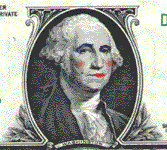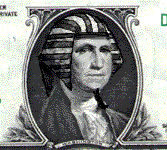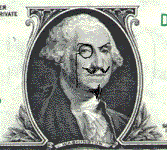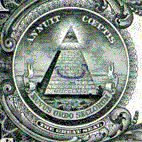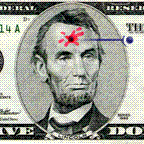 |
|
|
|
|
|
|
|
Funny Money
Fighting Inflation through Art
“Allow me to control the issue and the nation’s money
and I care not who makes its laws!”
— Amshell Rothschild
NOTE: This information is intended for entertainment purposes
only.
No actual pieces of legal tender were defaced in the making of this page.
Also note that much of the artwork is out of date.
The bills are being redesigned so frequently it's impossible to keep up.
No actual pieces of legal tender were defaced in the making of this page.
Also note that much of the artwork is out of date.
The bills are being redesigned so frequently it's impossible to keep up.
Like a blank wall overlooking a freeway, those little green and black printed pieces of paper we all collect and exchange so eagerly have great potential for self-expression. They can serve as canvasses for art, political commentary, advertising or even a place to jot the phone number of that fascinating person one just met at a bar.
The Father of Our Country
Brother George, the Osiris President
Just because it looks so good
Why use paper money for such purposes? Well, in the first place, Federal Reserve Notes aren’t “really” money — not the way the US Constitution defines it. The Federal Reserve is not even an agency of the United States government. Despite the name, the eagles and all the other fascist symbolism, as someone once said, “It is no more part of the government than Federal Express!” Rather it is a private corporation, owned by 12 major banks, most of them at least partially owned by foreigners (such as the Rothschilds and the Warburgs).
The Horn of Plenty
The Fed’s symbol shows Demeter, the goddess of wealth, holding the cornucopia of prosperity. It is quite apt, for the Federal Reserve basically controls the money supply by determining the lowest interest rates which all its member banks can borrow from it at. Thus to a large extent it determines stock prices and thereby prosperity. But whose prosperity is it? Certainly not the bulk of the American people, but rather those elite few who own shares in the international banks.
What, me worry?
Ever popular
A timeless classic
(Thanks Dave!)
“
Anyone seeking to prove the existance of conspiracies in America need look no further than the origin of our central bank. Here is a well-documented conspiracy involving the very names tied to modern secret societies,” as conspiracy theorist Jim Marrs writes. Indeed, names like Rothschild, Rockefeller, Morgan, to mention a few.
There were numerous attempts to foist such a parasitic entity on the United States before it finally succeeded under Woodrow Wilson as a Christmas gift to the bankers in 1913. (The same folks gave us the IRS several months later.) Presidents Jackson, Lincoln, and Kennedy all tried to stop this banking clique by printing “real” US dollars without charging the taxpayers interest.
Five months before Dallas, JFK issued an Executive Order for the Treasury to start issuing money backed by silver. This could have prevented the national debt from reaching the astronomical levels it is at today, since the Federal Reserve could not charge interest on the new money created to pay off the debt.
For the Federal Reserve creates the money, and then loans it to the government at interest. It prints currency through the U.S. Treasury, the government buys the debt, and the paper is flushed into the economy.
What a sweet deal! Especially considering that the Federal Reserve’s books are not open to the public and it has never been audited.
The money the Federal Reserve creates is by fiat, by will, just like magic. It’s all smoke and mirrors. If you try to redeem a Federal Reserve Note at a bank, you would not get anything of greater intrinsic worth than toilet paper — just another Federal Reserve Note. Those paper bills with their lovely printing are not backed by anything other than more paper, and the Fed can order as many printed as they like.
(Note: This is not to scorn toilet paper. In a post-apocalypse economy, toilet paper could become quite a valuable luxury item.)
It's just lines on paper, folks
Therefore, drawing on paper money can only be good for the economy. For the reason one doesn’t see more folk art or graffiti gracing paper money is that the bills are taken out of circulation as soon as they are noticed when they reach a bank. The paper is destroyed and has to be replaced.
So art, like any other means of consumption {such as lighting cigars) fights inflation because it uses the paper up, drawing down the money supply, even if by a insignificant amount. (Even a guard in a bank vault with nothing else to do his entire career might not cause a significant difference, unless he got ahold of some really big bills.) In any case, the banks have to replace the bills, no matter what condition they arrive in, or the whole tower of cards is revealed.
These artistic uses of currency should actually be quite agreeable to the Federal Reserve. After all, they are already considering expiration dates, magnetic strips and other devices to devalue the bills the longer they stay uncirculated. The only way to keep the bubble from popping is to keep those printing presses working, churning out those billions of pieces of paper that look like they are intrinsically worth something.
“It is well enough that the people of the nation do not understand our banking and monetary system for, if they did, I believe there would be a revolution before tomorrow morning.”
— Henry Ford
Previous — The Passion v. the Shroud




